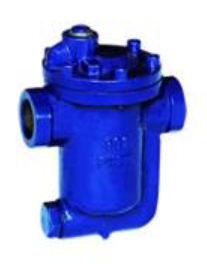In inverted bucket steam traps, the bucket within the trap is attached to a lever that opens and closes the trap valve in response to the bucket’s motion. When steam or air flows into the underside of the inverted bucket and condensate surrounds it on the outside, the steam causes the bucket to become buoyant and rise. In this position, the bucket will cause the trap valve to close.
There is a vent hole in the top of the bucket that allows a small amount of the
vapor to be released into the top of the trap, where it is discharged downstream.
As vapor escapes through the vent hole, condensate starts to fill the inside of the bucket, causing it to sink and allowing the lever to open the trap valve
Design & function of an Inverted Bucket Steam Trap
Design
● Inverted Bucket: The core component, an upside-down bucket, floats on the accumulated condensate. It is sealed at the top and open at the bottom.
● Valve Mechanism: Connected to the bucket, this system opens and closes to control condensate discharge. When the bucket rises with the condensate, it lifts the valve to allow condensate to drain.
● Housing/Body: The outer shell contains the internal components and provides connections to the steam and condensate lines.
● Vent Port: Allows non-condensable gases, such as air, to escape, improving system efficiency.
● Discharge Valve: Regulates the release of condensate and prevents steam loss.
● This design enables reliable condensate removal while minimizing steam loss, making it suitable for various steam system applications.
Function:
An inverted bucket steam trap removes condensate from steam systems by using an inverted bucket that floats in accumulated condensate. As the condensate level rises, the buoyant bucket lifts a connected valve mechanism, allowing the condensate to drain out.
When the bucket descends as the condensate is expelled, the valve closes, retaining steam. The trap often includes a vent port to release non-condensable gases like air, enhancing system efficiency. This design ensures effective removal of condensate while minimizing steam loss, making it suitable for high-pressure and high-temperature steam systems.
Advantages of the inverted bucket steam trap
● The inverted bucket steam trap can be made to withstand high pressures.
● Like a float-thermostatic steam trap, it has a good tolerance to water hammer conditions.
● Can be used on superheated steam lines with the addition of a check valve on the inlet.
● Failure mode is usually open, so it’s safer on those applications that require this feature, for example turbine drains.
Description:-
● Body: Carbon Steel, Stainless Steel, Ductile Iron
● Nominal Diameter: DN20 to DN32
● Nominal Pressure: PN10 to PN64
Showing the single result



